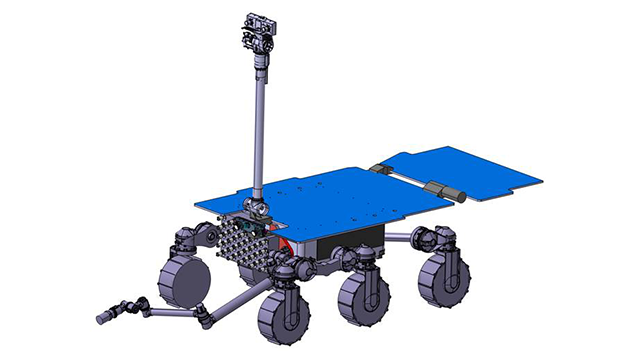Fetch rover! Robot to retrieve Mars rocks
- Published

The fetch rover would look something like this
UK engineers will design a robot that can retrieve rock samples on Mars so they can be sent to Earth for study.
The European Space Agency is issuing contracts to industry to spec the technology needed for what will be a complex joint undertaking with the US.
Aerospace giant Airbus will scope the concept for a surface "fetch rover" at its Stevenage centre north of London.
Esa and the American space agency (Nasa) expect to send the sample-return equipment to the Red Planet in 2026.
"It will be a relatively small rover - about 130kg; but the requirements are very demanding," said Ben Boyes who will lead the feasibility team at Airbus.
"The vehicle will have to cover large distances using a high degree of autonomy, planning its own path ahead day after day," he told BBC News.
Esa and Nasa signed a letter of intent in April committing themselves to bringing back pieces of Martian rock and soil to Earth before the end of the next decade.
It will be a daring venture that will be done in stages and take several years to complete.
How is the plan shaping up?
Nasa will send a rover to Mars in 2020. This will search for interesting materials, drilling and scooping them from the surface and caching them in canisters. These will be dropped at various depot points. There could be 30-plus of these pen-sized tubes awaiting pick-up.
In 2026, the recovery mission will be launched. The Americans will land an "ascent vehicle" (essentially a rocket) on Mars together with the European fetch rover. The latter will trundle off to find and gather up the canisters, delivering them back to the rocket.
Within roughly 150 days, the space agencies want the canisters lifted off Mars by the ascent vehicle. It will rendezvous with a European orbiter that will take charge of the samples and carry them to Earth. A descent capsule will bring down the precious cargo somewhere over the US.
This "architecture" is still being worked on, and the technologies have to be shown to be achievable. So, the concepts will likely evolve, as could the timing of the different stages. The agencies might stretch the schedules to spread out what will be a considerable financial cost.

Artwork: A rocket would be needed to get the samples off Mars
Why does this matter?
Numerous satellites have been sent to study Mars from above, and seven landers have so far touched down to sift its surface materials. But scientists say some of the biggest questions about the planet - such as whether it has ever hosted life - can only really be answered if rock and soil is brought to Earth.
No amount of miniaturisation can give Martian landers the capabilities of the most modern analytical tools now available in research laboratories.
Mars Sample Return is the next big thing in planetary science.

The Americans have been devising methods to cache samples for later collection
Tell me more about the fetch rover
Airbus in Stevenage has been selected for the €4.45m (£3.90m) feasibility work because it is already building Esa's ExoMars rover, which will go to the Red Planet to do in-situ science, starting in 2021.
The requirements for the fetch rover will be very different, however.
Unlike the 220kg ExoMars robot, the new vehicle will not carry a suite of research instruments; its one job will be to retrieve the cache canisters.
"One of the cool new technologies we want for the rover is to be able to detect the canisters visually from a distance and then drive over and automatically pick them up," explained Mr Boyes.
"A robot arm will reach out and lift them into a store on the front of the rover."
What is the next phase?
Nasa's Jet Propulsion Laboratory (JPL) in California is working with American industry to spec its hardware. Esa is issuing contracts to European industry for its own mission elements.
As is Esa's normal practice, parallel feasibility studies are done in different companies to find the best hardware solutions.
The French-Italian firm Thales Alenia Space (TAS) will also examine aspects of the rover design. Likewise, TAS and Airbus will examine possibilities for the Earth-delivery orbiter.
The aim is to have concepts and costings that Europe's space ministers can approve when they meet for their big council gathering at the end of 2019.
Speed is of the essence; it takes time to build and test space technology, and the fetch rover needs to be delivered to JPL to be integrated with the ascent vehicle and landing mechanism early in 2025 - if the 2026 launch target is to be met.
Tell me something smart
Once the fetch rover has handed over the sample canisters to the ascent vehicle, it will retire to a safe distance to film the ascent.
"That's going to be very exciting - to record the first ever rocket launch on Mars. It's a nice-to-have at the end of the programme," said Mr Boyes.
David Parker is director of human and robotic exploration at Esa. He told BBC News: "There has long been an interest in doing Mars Sample Return, but this is really the first time we've been working with Nasa in such a systematic way; and let's cross our fingers that it all works out.
"I have to say the science is really fantastic. Someone showed me what they could do with 50-year-old Apollo samples brought back from the Moon. So, samples returned from Mars will be used in another 50 years' time."
Jonathan.Amos-INTERNET@bbc.co.uk, external and follow me on Twitter: @BBCAmos, external